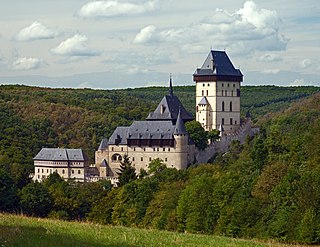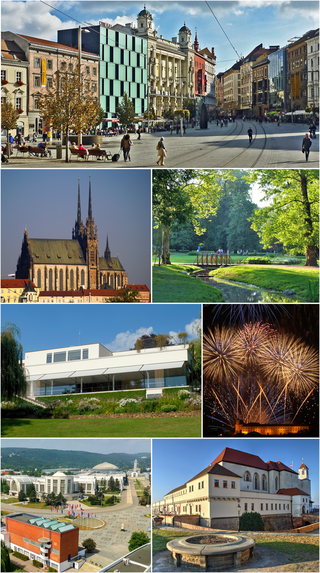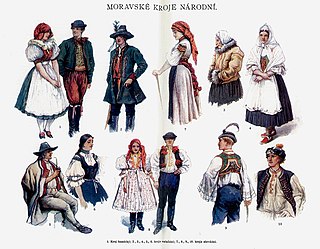Activities
The party organises open air actions, meetings and sit-ins, "candle marches" (founded at 2005) in Brno and Olomouc, "pilgrimages to the Morava river spring", demonstrations against "Bohemiazation" etc.
During a 'candle march' on 27 February 2010, forty party members decorated with numerous Moravian flags marched through the historical part of Brno to the pre-war Moravian Diet building, which Moravané claims to be occupied by a "foreign state", and the Moravian Square. The protest was poorly received by passers-by, with one on-looker noting "at this rate, the [Moravian people] will be looked on as fools". [4] The march was not registered with the police and was later halted. [4] On 25 July 2010, Moravané participated in a demonstration in Moravský Krumlov to attempt to halt a collection of Alfons Mucha paintings named The Slav Epic from being returned to Prague.

Bohemia is the westernmost and largest historical region of the Czech Republic. Bohemia can also refer to a wider area consisting of the historical Lands of the Bohemian Crown ruled by the Bohemian kings, including Moravia and Czech Silesia, in which case the smaller region is referred to as Bohemia proper as a means of distinction.

The Czech Republic is a landlocked country in Central Europe. It is bordered by Germany to the west, Austria to the south, Slovakia to the east and Poland to the north. It consists mostly of low hills and plateaus surrounded along the borders by low mountains. Two areas of lowlands follow the Elbe river and the Morava river. About a third of the area of the Czech Republic is covered by forests.

Moravia is a historical region in the east of the Czech Republic and one of three historical Czech lands, with Bohemia and Czech Silesia.

Brno is a city in the South Moravian Region of the Czech Republic. Located at the confluence of the Svitava and Svratka rivers, Brno has about 400,000 inhabitants, making it the second-largest city in the Czech Republic after the capital, Prague, and one of the 100 largest cities of the European Union. The Brno metropolitan area has approximately 730,000 inhabitants.

Moravians are a West Slavic ethnic group from the Moravia region of the Czech Republic, who speak the Moravian dialects of Czech or Common Czech or a mixed form of both. Along with the Silesians of the Czech Republic, a part of the population to identify ethnically as Moravian has registered in Czech censuses since 1991. The figure has fluctuated and in the 2011 census, 6.01% of the Czech population declared Moravian as their ethnicity. Smaller pockets of people declaring Moravian ethnicity are also native to neighboring Slovakia.
The German-speaking population in the interwar Czechoslovak Republic, 23.6% of the population at the 1921 census, usually refers to the Sudeten Germans, although there were other German ethno-linguistic enclaves elsewhere in Czechoslovakia inhabited by Carpathian Germans, and among the German-speaking urban dwellers there were ethnic Germans and/or Austrians as well as German-speaking Jews. 14% of the Czechoslovak Jews considered themselves Germans in the 1921 census, but a much higher percentage declared German as their colloquial tongue during the last censuses under the Austro-Hungarian Empire.

The Czech lands or the Bohemian lands is a historical-geographical term which, in a historical and cultural context, denotes the three historical regions of Bohemia, Moravia, and Czech Silesia out of which Czechoslovakia, and later the Czech Republic, were formed. Together the three have formed the Czech part of Czechoslovakia since 1918, and the Czech Republic since 1 January 1993.

Regions of the Czech Republic are higher-level territorial self-governing units of the Czech Republic.

German Bohemians, later known as Sudeten Germans, were ethnic Germans living in the Czech lands of the Bohemian Crown, which later became an integral part of Czechoslovakia. Before 1945, over three million German Bohemians constituted about 23% of the population of the whole country and about 29.5% of the population of Bohemia and Moravia. Ethnic Germans migrated into the Kingdom of Bohemia, an electoral territory of the Holy Roman Empire, from the 11th century, mostly in the border regions of what was later called the "Sudetenland", which was named after the Sudeten Mountains.
This article deals with historic administrative divisions of Czechoslovakia up to 1992, when the country was split into the Czech Republic and Slovakia.
The history of Moravia, one of the Czech lands, is diverse and characterized by many periods of foreign governance.

Moravian dialects are the varieties of Czech spoken in Moravia, a historical region in the east of the Czech Republic. There are more forms of the Czech language used in Moravia than in the rest of the Czech Republic. The main four groups of dialects are the Bohemian-Moravian group, the Central Moravian group, the Eastern Moravian group and the Lach (Silesian) group. While the forms are generally viewed as regional variants of Czech, some Moravians claim them to be one separate Moravian language.

The Margraviate of Moravia was one of the Lands of the Bohemian Crown within the Holy Roman Empire and then Austria-Hungary, existing from 1182 to 1918. It was officially administered by a margrave in cooperation with a provincial diet. It was variously a de facto independent state, and also subject to the Duchy, later the Kingdom of Bohemia. It comprised the historical region called Moravia, which lies within the present-day Czech Republic.

The Moravians were a West Slavic tribe in the Early Middle Ages. Although it is not known exactly when the Moravian tribe was founded, Czech historian Dušan Třeštík claimed that the tribe was formed between the turn of the 6th century to the 7th century, around the same time as the other Slavic tribes. In the 9th century Moravians settled mainly around the historic region of Moravia and Western Slovakia, but also in parts of Lower Austria and Upper Hungary.

The Movement for Autonomous Democracy–Party for Moravia and Silesia was a political party in Czechoslovakia and the Czech Republic that sought autonomy for Moravia.

The Vyškov Gate is a geomorphological feature in the Moravia. It is formed by the depression between the Western Carpathian Mountains in the east and the Bohemian massif in the west. The drainage divide between the upper River Haná to the River Morava of the Danube basin runs through it and Rakovec brook. The gate is between the Upper Morava Valley and the Dyje–Svratka Valley, all in Outer Subcarpathian depression.

The coat of arms of Moravia has been used for centuries to represent Moravia, a traditional province in the present-day Czech Republic. The coat of arms is also present in a field of the coat of arms of the Czech Republic.

Zdeňka Wiedermannová-Motyčková was a Moravian teacher, journal editor, and women's rights activist. Born into a family of progressive educators, she studied to become a teacher, graduating in 1886. Her Catholic education led her to more conservative values than her family's, but after teaching for several years, she began to recognize the disparities between women and men teachers, as well as those of their students. By 1898, she was publicly calling for equal pay for equal work and campaigning for equal education for boys and girls. In 1902, Wiedermannová founded and became chair of the Moravian Teachers Union, whose focus was to professionalize teaching standards. The following year, she opened a Girls' Academy in Brno, hoping later to include secondary education there. As the Austro-Hungarian Empire provided little funding for girls' education, she held lectures to provide for the operating costs of the academy. Finally in 1908, she successfully established the first girls' secondary school in Moravia.

The Moravian Land Movement is a political party in the Czech Republic that campaigns for the establishment of an autonomous region in Moravia and Czech Silesia. It was founded in 2018 as a breakaway from Moravané and claims to be the successor to the Movement for Autonomous Democracy–Party for Moravia and Silesia.
















